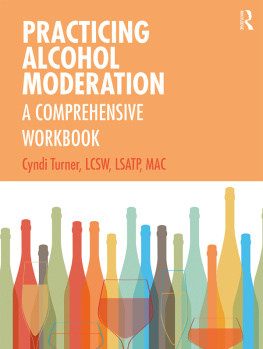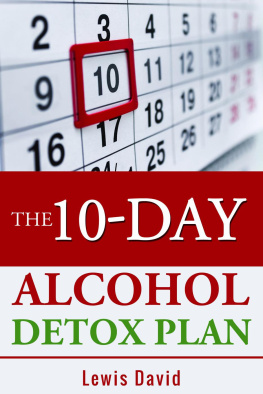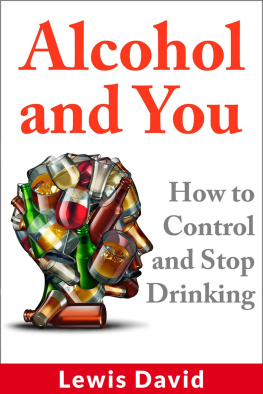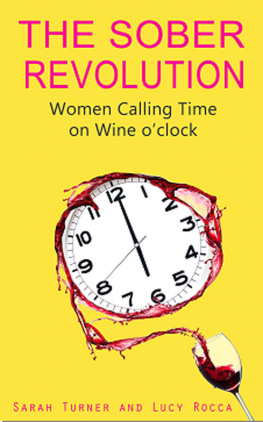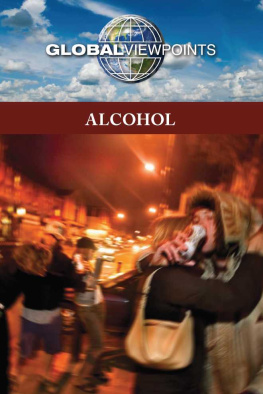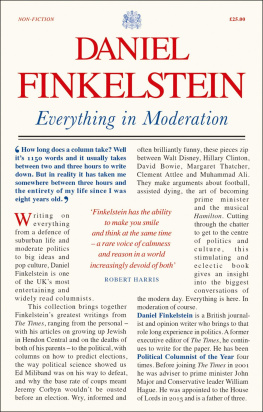I want to express my appreciation to many of the same people as I did in The Clinicians Guide to Alcohol Moderation: Alternative Methods and Management Techniques as they were written at the same time.
Book Mommy got even grouchier while meeting the deadline for this one. Kaitlyn and Jacklyn, you are amazing. Both of you helped me stay sane by making me laugh and helping around the house when I needed organization around me. Your independence and drive to do the right thing when no one is looking is beyond each of your years.
Thank you, Mike, for helping me see that we would get through this difficult phase of life. I cant wait to sit on a white sand beach with you.
I appreciate my business partners and friends Craig James and Angie Harris. Craig, without your daily operations we would not impacted the lives of as many people at Insight Into Action Therapy as we did. Angie, without your leadership we could not have opened our intensive outpatient program with Insight Recovery Centers.
Thank you again to the Worlds Greatest Beta Reader, Bill Schmidt, reader of almost 300 manuscripts, who is also my father. Your copyediting, feedback, and inspirational messages kept me motivated and laughing during this challenging period of my life. Thank you for introducing me to fellow author Russel F. Moran, whose comments helped make my message more understandable.
Chelsea Sievers of Level 27 Media, your images brought my words to life.
I continue to be grateful to all of the harm reduction clinicians who challenged the status quo while I was a young therapist and paved the way for alcohol moderation to become a mainstream treatment option.
- . Egelko, B. (2007, September 8). Appeals court say requirement to attend AA unconstitutional. San Francisco Chronicle.
- . Substance Abuse and Mental Health Services Administration. (2012, February). Whats recovery? SAMHSAs working definition. Publication ID: PEP12-RECDEF.
- . U.S. Department of Health and Human Services (HHS), Office of the Surgeon General. (2016, November). Facing addiction in America: The surgeon generals report on alcohol, drugs, and health. Washington, DC: HHS.
- . Springer, E. (1991). Effective AIDS prevention with active drug users: The harm reduction model. In M. Shernoff (Ed.), Counseling chemically dependent people with HIV illness (pp. 141158). New York: Harrington Park Press.
- . Tatarsky, A. & Marlatt, A. (2010). State of the art in harm reduction psychotherapy: An emerging treatment for substance misuse. Journal of Clinical Psychology: In Session 66(2): 117122. doi: 10.1002/jclp.20672
- . Denning, P. & Little, J. (2017). Over the influence: The harm reduction guide to controlling your drug and alcohol use (2nd ed.). New York: The Guilford Press.
- . Mann, K., Aubin, H.-J. & Witikiewitz, K. (2017, September 22). Reduced drinking in alcohol dependence treatment, what is the evidence? European Addiction Research 23: 219230. doi: 10.1159/000481348
- . Turner, C. (2020). The clinicians guide to alcohol moderation: Alternative methods and management techniques. New York, NY: Routledge.
- . Miller, W.R. (2019, July 7). Personal communication.
- . Miller, W.R. & Munoz, R.F. (2013). Controlling your drinking, 2nd ed: Tools to make moderation work for you. New York: The Guilford Press.
- . U.S. Department of Health and Human Services and U.S. Department of Agriculture. (2015). 20152020 Dietary Guidelines for Americans (External 8th ed.). Washington, DC.
- . Rotgers, F., Kern, M.F. & Hoeltzel, R. (2002). Responsible drinking: A moderation management approach for problem drinkers. Oakland, CA: New Harbinger Publications.
- . Turner, C. (2020). The clinicians guide to alcohol moderation: Alternative methods and management techniques. New York, NY: Routledge.
- . American Psychiatric Association. (2013). Diagnostic and statistical manual of mental disorders (5th ed.). Washington, DC: American Psychiatric Association.
- .
- . American Psychiatric Association. (2013). Diagnostic and statistical manual of mental disorders (5th ed.). Washington, DC: American Psychiatric Association.
- . Turner, C. (2020). The clinicians guide to alcohol moderation: Alternative methods and management techniques. New York, NY: Routledge.
- . Griswold, M.G., Fullman, N., Hawley, C., Arian, N., Zimsen, S., Tymeson, H.D., Venkateswaran, V., Tapp, A.D., Forouzanfar, M., Salama, J.S., Abate, K., Abate, D., Abay, S., Abbafati, C., Suliankatchi, R., Zegeye, A., Aboyans, V., Abrar, M.M. & Acharya, P. (2018). Alcohol use and burden for 195 countries and territories, 19902016: A systematic analysis for the Global Burden of Disease Study 2016. Lancet 392: 10151035.
- . Newman, T. (2017, December 22). All about the central nervous system. Medical News Today.
- . Banerjee, N. (2014). Neurotransmitters in alcoholism: A review of neurobiological and genetic studies. Indian Journal of Human Genetics 20(1): 2031. doi: 10.4103/0971-6866.132750
- . Piano, M.R. (2017). Alcohols effects on the cardiovascular system. Alcohol Research 38(2): 219241.
- . Chowdhury, P. & Gupta, P. (2006). Pathology of alcoholic pancreatitis: An overview. World Journal of Gastroenterology 12(46): 74217427. doi: 10.3748/wjg.v12.i46.7421
- . Sarkar, D., Jung, M.K. & Wang, H.J. (2015). Alcohol and the immune system. Alcohol Research: Current Reviews 37(2): 153155.
- . May, P.A. & Gossage, J.P. (2011). Fetal alcohol spectrum disorders. Alcohol Research and Health 34(1): 1623.
- . Wells, S., Graham, K. & West, P. (2000, July). Alcohol-related aggression in the general population. Journal of Studies on Alcohol 61(4): 626632.
- . Bush, B. & Hudson, T. (2010). The role of cortisol in sleep. Natural Medicine Journal 2(6).
- . Cains, S. et al. (2017). Agrp neuron activity is required for alcohol-induced overeating. Nature Communication 8: 14014. doi: 10.1038/ncomms14014
- . Prochaska, J.O., DiClemente, C.C. & Norcross, J.C. (1992). In search of how people change: Applications to the addictive behaviors. American Psychologist 47: 11021114. PMID: 1329589.
- . Prochaska, J.O., Norcross, J.C. & DiClemente, C.C. (1994). Changing for good. New York: Morrow. ISBN: 0-380-72572-X.
- . Witte, K. & Allen, M. (2000). A meta-analysis of fear appeals: Implications for effective public health programs. Health Education and Behavior 27(5): 591615.
- . Sanchez-Craig, M. (2013). Saying when: How to quit drinking or cut down. Toronto, Canada: Center for Addiction and Mental Health.
- . Kadam, M., Sinha, A., Nimkar, S., Matcheswalla, Y. & De Sousa, A. (2017). A comparative study of factors associated with relapse in alcohol dependence and opioid dependence. Indian Journal of Psychological Medicine 39(5): 627633. doi: 10.4103/IJPSYM.IJPSYM_356_17
- . National Institute on Alcohol Abuse and Alcoholism. (1998, July). Alcohol alert no. 41. Bethesda, MD.
- . Witikiewitz, K., Bowen, S., Harropt, E.N., Douglas, H., Enkema, M. & Sedgwick. (2014). Mindfulness-based treatment to prevent addictive behavior relapse: Theoretical models and hypothesized mechanisms of change. Substance Use and Misuse 49(5): 513524. doi: 10.3109/10826084.2014.891845
- . Griffin, K. (2010). Interview with G. Alan Marlatt: Surfing the Urge. Inquiring Mind. 26(2).
- . Khooury, L., Tang, Y.L., Bradley, B., Cubells, J.F. & Ressler, K.J. (2010, December). Substance use, childhood traumatic experience, and post traumatic stress disorder in an urban civilian population. Depression and Anxiety 27(12): 10771086.

